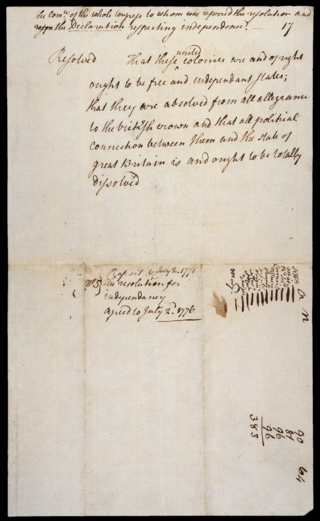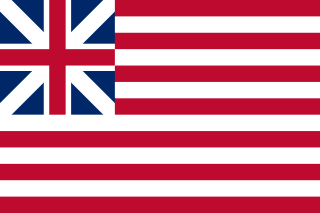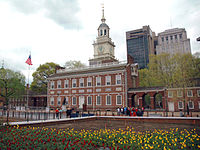
The Declaration of Independence, formally titled The unanimous Declaration of the thirteen united States of America, is the founding document of the United States. On July 4, 1776, it was adopted unanimously by the 56 delegates to the Second Continental Congress, who had convened at the Pennsylvania State House, later renamed Independence Hall, in the colonial era capital of Philadelphia. The declaration explains to the world why the Thirteen Colonies regarded themselves as independent sovereign states no longer subject to British colonial rule.

Benjamin Harrison V was an American planter, merchant, and politician who served as a legislator in colonial Virginia, following his namesakes' tradition of public service. He was a signer of the Continental Association, as well as the United States Declaration of Independence, and was one of the nation's Founding Fathers. He served as Virginia's governor from 1781 to 1784.

1776 is a musical with music and lyrics by Sherman Edwards and a book by Peter Stone. The show is based on the events leading up to the signing of the Declaration of Independence, telling a story of the efforts of John Adams to persuade his colleagues to vote for American independence and to sign the document. The show premiered on Broadway in 1969 where it received acclaim and won three Tony Awards, including Best Musical. The original production starred William Daniels as Adams, Ken Howard as Thomas Jefferson and Howard Da Silva as Benjamin Franklin.

Edward Rutledge was an American Founding Father and politician who signed the Continental Association and was the youngest signatory of the Declaration of Independence. He later served as the 39th governor of South Carolina.

The Olive Branch Petition was adopted by the Second Continental Congress on July 5, 1775, and signed on July 8 in a final attempt to avoid war between Great Britain and the Thirteen Colonies in America. The Congress had already authorized the invasion of Canada more than a week earlier, but the petition affirmed American loyalty to Great Britain and entreated King George III to prevent further conflict. It was followed by the July 6 Declaration of the Causes and Necessity of Taking Up Arms, however, which made its success unlikely in London. In August 1775, the colonies were formally declared to be in rebellion by the Proclamation of Rebellion, and the petition was rejected by the British government; King George had refused to read it before declaring the colonists traitors.

The Second Continental Congress was the late-18th-century meeting of delegates from the Thirteen Colonies that united in support of the American Revolution and its associated Revolutionary War, which established American independence from the British Empire. The Congress created a new country that it first named the United Colonies, and in 1776, renamed the United States of America. The Congress began convening in Philadelphia, on May 10, 1775, with representatives from 12 of the 13 colonies, after the Battles of Lexington and Concord.

John Dickinson, a Founding Father of the United States, was an attorney and politician from Philadelphia, Pennsylvania, and Wilmington, Delaware. Dickinson was known as the "Penman of the Revolution" for his twelve Letters from a Farmer in Pennsylvania, published individually in 1767 and 1768, and he also wrote "The Liberty Song" in 1768.

The Founding Fathers of the United States, commonly referred to simply as the Founding Fathers, were a group of late 18th century American revolutionary leaders who united the Thirteen Colonies, oversaw the War of Independence from Great Britain, established the United States, and crafted a framework of government for the new nation.
What is known today as the Tryon Resolves was a brief declaration adopted and signed by "subscribers" to the Tryon County Association that was formed in Tryon County, North Carolina in the early days of the American Revolution. In the Resolves—a modern name for the Association's charter document—the county representatives vowed resistance to the increasingly coercive actions being enacted by the government of Great Britain against its North American colonies. The document was signed on August 14, 1775, but—like other similar declarations of the time—stopped short of calling for total independence from Britain.

The Lee Resolution, also known as "The Resolution for Independence", was the formal assertion passed by the Second Continental Congress on July 2, 1776, which resolved that the Thirteen Colonies, then referred to as the United Colonies, were "free and independent States" and separate from the British Empire, which created what became the United States of America. News of this act was published that evening in The Pennsylvania Evening Post and the next day in The Pennsylvania Gazette. The Declaration of Independence officially announced and explained the case for independence and was approved two days later, on July 4, 1776.

Pennsylvania was the site of many key events associated with the American Revolution and American Revolutionary War. The city of Philadelphia, then capital of the Thirteen Colonies and the largest city in the colonies, was a gathering place for the Founding Fathers who discussed, debated, developed, and ultimately implemented many of the acts, including signing the Declaration of Independence, that inspired and launched the revolution and the quest for independence from the British Empire.

The United Colonies was the name used by the Second Continental Congress in Philadelphia to describe the emerging nation comprising the Thirteen Colonies in 1775 and 1776, before and as independence was declared. Continental currency banknotes displayed the name 'The United Colonies' from May 1775 until February 1777, and the name was being used as a colloquial phrase to refer to the colonies as a whole before the Second Congress met, although the precise place or date of its origin is unknown.

The Committee of Five of the Second Continental Congress was a group of five members who drafted and presented to the full Congress in Pennsylvania State House what would become the United States Declaration of Independence of July 4, 1776. This Declaration committee operated from June 11, 1776, until July 5, 1776, the day on which the Declaration was published.

1776 is a 1972 American historical musical comedy drama film directed by Peter H. Hunt and written by Peter Stone, based on his book for the 1969 Broadway musical of the same name, with music and lyrics by Sherman Edwards. Set in Philadelphia in the summer of 1776, it is a fictionalized account of the events leading up to the signing of the Declaration of Independence. The film stars William Daniels, Howard da Silva, Donald Madden, John Cullum, Ken Howard and Blythe Danner.
The Conciliatory Resolution was a resolution passed by the British Parliament in an attempt to reach a peaceful settlement with the Thirteen Colonies two months prior to the outbreak of the American Revolutionary War.

The Petition to the King was a petition sent to King George III by the First Continental Congress in 1774, calling for the repeal of the Intolerable Acts. The King's rejection of the Petition, was one of the causes of the later United States Declaration of Independence and American Revolutionary War. The Continental Congress had hoped to resolve conflict without a war.
Thomas Jefferson, the third president of the United States, owned more than 600 slaves during his adult life. Jefferson freed two slaves while he lived, and five others were freed after his death, including two of his children from his relationship with his slave Sally Hemings. His other two children with Hemings were allowed to escape without pursuit. After his death, the rest of the slaves were sold to pay off his estate's debts.

The physical history of the United States Declaration of Independence spans from its original drafting in 1776 into the discovery of historical documents in modern time. This includes a number of drafts, handwritten copies, and published broadsides. The Declaration of Independence states that the thirteen colonies were now the "United Colonies" which "are, and of Right ought to be Free and Independent States"; and were no longer a part of the British Empire.

The signing of the United States Declaration of Independence occurred primarily on August 2, 1776, at the Pennsylvania State House in Philadelphia, later to become known as Independence Hall. The 56 delegates to the Second Continental Congress represented the 13 colonies, 12 of which voted to approve the Declaration of Independence on July 4, 1776. The New York delegation abstained because they had not yet received instructions from Albany to vote for independence. The Declaration proclaimed the signatory colonies were now "free and independent States", no longer colonies of the Kingdom of Great Britain and, thus, no longer a part of the British Empire. The signers’ names are grouped by state, with the exception of John Hancock, as President of the Continental Congress; the states are arranged geographically from south to north, with Button Gwinnett from Georgia first, and Matthew Thornton from New Hampshire last.

The 27 grievances is a section from the United States Declaration of Independence. The Second Continental Congress's Committee of Five drafted the document listing their grievances with the actions and decisions of King George III with regard to the Colonies in North America. The Second Continental Congress voted unanimously to adopt and issue the Declaration of Independence on July 4, 1776.















